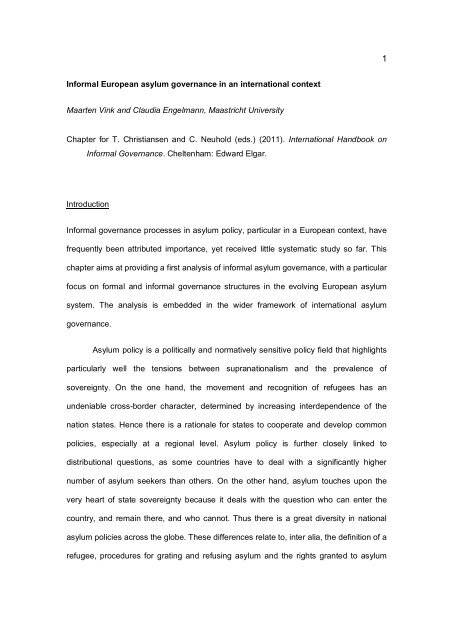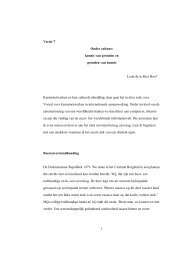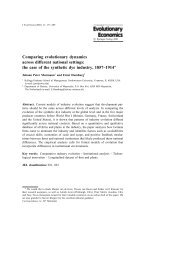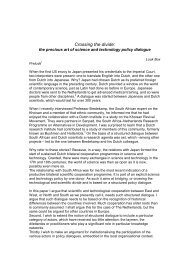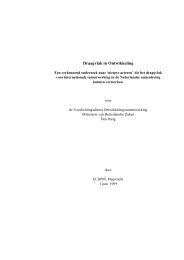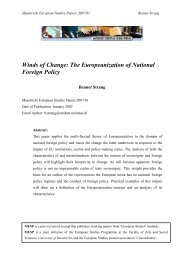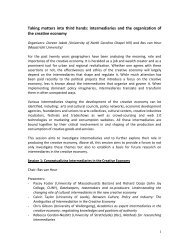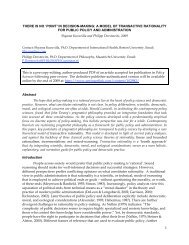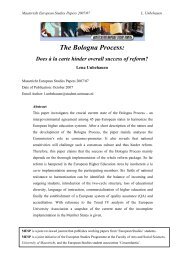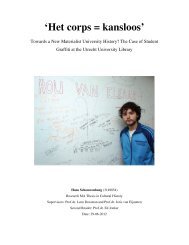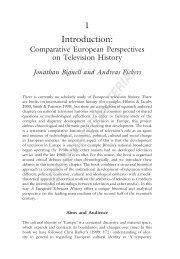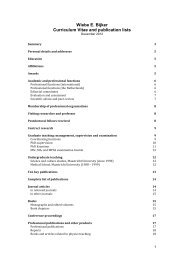Informal European asylum governance in an international context ...
Informal European asylum governance in an international context ...
Informal European asylum governance in an international context ...
You also want an ePaper? Increase the reach of your titles
YUMPU automatically turns print PDFs into web optimized ePapers that Google loves.
<strong>Informal</strong> <strong>Europe<strong>an</strong></strong> <strong>asylum</strong> <strong>govern<strong>an</strong>ce</strong> <strong>in</strong> <strong>an</strong> <strong>in</strong>ternational <strong>context</strong><br />
Maarten V<strong>in</strong>k <strong>an</strong>d Claudia Engelm<strong>an</strong>n, Maastricht University<br />
Chapter for T. Christi<strong>an</strong>sen <strong>an</strong>d C. Neuhold (eds.) (2011). International H<strong>an</strong>dbook on<br />
<strong>Informal</strong> Govern<strong>an</strong>ce. Cheltenham: Edward Elgar.<br />
Introduction<br />
<strong>Informal</strong> <strong>govern<strong>an</strong>ce</strong> processes <strong>in</strong> <strong>asylum</strong> policy, particular <strong>in</strong> a <strong>Europe<strong>an</strong></strong> <strong>context</strong>, have<br />
frequently been attributed import<strong>an</strong>ce, yet received little systematic study so far. This<br />
chapter aims at provid<strong>in</strong>g a first <strong>an</strong>alysis of <strong>in</strong>formal <strong>asylum</strong> <strong>govern<strong>an</strong>ce</strong>, with a particular<br />
focus on formal <strong>an</strong>d <strong>in</strong>formal <strong>govern<strong>an</strong>ce</strong> structures <strong>in</strong> the evolv<strong>in</strong>g <strong>Europe<strong>an</strong></strong> <strong>asylum</strong><br />
system. The <strong>an</strong>alysis is embedded <strong>in</strong> the wider framework of <strong>in</strong>ternational <strong>asylum</strong><br />
<strong>govern<strong>an</strong>ce</strong>.<br />
Asylum policy is a politically <strong>an</strong>d normatively sensitive policy field that highlights<br />
particularly well the tensions between supr<strong>an</strong>ationalism <strong>an</strong>d the prevalence of<br />
sovereignty. On the one h<strong>an</strong>d, the movement <strong>an</strong>d recognition of refugees has <strong>an</strong><br />
undeniable cross-border character, determ<strong>in</strong>ed by <strong>in</strong>creas<strong>in</strong>g <strong>in</strong>terdependence of the<br />
nation states. Hence there is a rationale for states to cooperate <strong>an</strong>d develop common<br />
policies, especially at a regional level. Asylum policy is further closely l<strong>in</strong>ked to<br />
distributional questions, as some countries have to deal with a signific<strong>an</strong>tly higher<br />
number of <strong>asylum</strong> seekers th<strong>an</strong> others. On the other h<strong>an</strong>d, <strong>asylum</strong> touches upon the<br />
very heart of state sovereignty because it deals with the question who c<strong>an</strong> enter the<br />
country, <strong>an</strong>d rema<strong>in</strong> there, <strong>an</strong>d who c<strong>an</strong>not. Thus there is a great diversity <strong>in</strong> national<br />
<strong>asylum</strong> policies across the globe. These differences relate to, <strong>in</strong>ter alia, the def<strong>in</strong>ition of a<br />
refugee, procedures for grat<strong>in</strong>g <strong>an</strong>d refus<strong>in</strong>g <strong>asylum</strong> <strong>an</strong>d the rights gr<strong>an</strong>ted to <strong>asylum</strong><br />
1
seekers. There have been several efforts at the <strong>Europe<strong>an</strong></strong> level to harmonize <strong>asylum</strong><br />
policies across EU member states. While <strong>in</strong>creas<strong>in</strong>g policy competence by successive<br />
treaty ch<strong>an</strong>ges have partly formalized <strong>govern<strong>an</strong>ce</strong> structures <strong>an</strong>d led toward the<br />
development of common st<strong>an</strong>dards, <strong>asylum</strong> policymak<strong>in</strong>g still depends to a large degree<br />
on exch<strong>an</strong>ge outside formal decision-mak<strong>in</strong>g structures. In this chapter we illustrate<br />
these <strong>in</strong>formal <strong>govern<strong>an</strong>ce</strong> structures with the example of <strong>in</strong>formal <strong>in</strong>formation exch<strong>an</strong>ge<br />
mech<strong>an</strong>isms <strong>in</strong> the area of country of orig<strong>in</strong>-<strong>in</strong>formation (COI). The case study is<br />
embedded <strong>an</strong>d preceded by <strong>an</strong> <strong>an</strong>alysis of the development of <strong>in</strong>formal <strong>Europe<strong>an</strong></strong><br />
<strong>asylum</strong> <strong>govern<strong>an</strong>ce</strong> with<strong>in</strong> the <strong>in</strong>ternational hum<strong>an</strong> rights framework of the 1951 Geneva<br />
Convention.<br />
Christi<strong>an</strong>sen, Føllesdal <strong>an</strong>d Piattoni consider <strong>in</strong>formal <strong>govern<strong>an</strong>ce</strong> as ‘the<br />
operation of networks of <strong>in</strong>dividual <strong>an</strong>d collective, public <strong>an</strong>d private actors pursu<strong>in</strong>g<br />
common goals – which lead to cooperation, patterned relations <strong>an</strong>d public decisions –<br />
through regular though non-codified <strong>an</strong>d not publicly s<strong>an</strong>ctioned exch<strong>an</strong>ges <strong>in</strong> the<br />
<strong>in</strong>stitutional <strong>context</strong> of the <strong>Europe<strong>an</strong></strong> Union.’ (Christi<strong>an</strong>sen et al. 2003, p.7). The two<br />
elements that are central to the def<strong>in</strong>ition of <strong>in</strong>formal <strong>govern<strong>an</strong>ce</strong> are, first, <strong>in</strong>formation<br />
exch<strong>an</strong>ges based on procedures that are not codified by formal or written rules <strong>an</strong>d,<br />
second, <strong>in</strong>formation exch<strong>an</strong>ges are not publicly s<strong>an</strong>ctioned. In the field of <strong>asylum</strong><br />
<strong>govern<strong>an</strong>ce</strong>, we see a variety of <strong>in</strong>stitutional venues develop s<strong>in</strong>ce the early 1990s, after<br />
the <strong>in</strong>troduction of <strong>asylum</strong> policy as a new area of Union competence under the<br />
Maastricht Treaty, r<strong>an</strong>g<strong>in</strong>g from more the ‘formal’ end of the scale (codification <strong>in</strong><br />
treaties, such as the st<strong>an</strong>d<strong>in</strong>g committee with<strong>in</strong> the Council to promote cooperation on<br />
<strong>in</strong>ternal security set up under Article 71 TFEU (ex Article 36 TEU)) to medi<strong>an</strong> forms<br />
(codification <strong>in</strong> terms of references, m<strong>an</strong>dates) to the ‘<strong>in</strong>formal’ end (no codification at<br />
all). <strong>Informal</strong> politics occur <strong>in</strong> different k<strong>in</strong>ds, such as <strong>in</strong> policy networks (the relationship<br />
between the <strong>Europe<strong>an</strong></strong> Commission <strong>an</strong>d <strong>in</strong>terest groups), <strong>in</strong> advocacy coalitions <strong>an</strong>d<br />
2
epistemic communities or <strong>in</strong> <strong>in</strong>ter-<strong>in</strong>stitutional relations (between Commission, Council,<br />
Parliament, member states <strong>an</strong>d even the Court of Justice) (Christi<strong>an</strong>sen et al 2003, p.4).<br />
This chapter seeks to focus on the latter by mapp<strong>in</strong>g formal <strong>an</strong>d <strong>in</strong>formal<br />
<strong>in</strong>tergovernmental exch<strong>an</strong>ge.<br />
The chapter is divided <strong>in</strong>to three sections. Section one presents <strong>an</strong> overview of<br />
the <strong>in</strong>ternational <strong>asylum</strong> <strong>govern<strong>an</strong>ce</strong> structures evolved around the 1951 Geneva<br />
Conventions. Section two focuses on <strong>Europe<strong>an</strong></strong> <strong>asylum</strong> <strong>govern<strong>an</strong>ce</strong> show<strong>in</strong>g that<br />
<strong>in</strong>creas<strong>in</strong>g policy competences by successive treaty ch<strong>an</strong>ges have partly formalized<br />
<strong>govern<strong>an</strong>ce</strong> structures, although <strong>in</strong>formality <strong>an</strong>d the exch<strong>an</strong>ge outside formal decision-<br />
mak<strong>in</strong>g structures rema<strong>in</strong>s <strong>in</strong> m<strong>an</strong>y bodies. Section three exemplifies one area where<br />
<strong>in</strong>formality still prevails by look<strong>in</strong>g at the exch<strong>an</strong>ge of <strong>in</strong>formation on countries of orig<strong>in</strong>.<br />
Asylum <strong>govern<strong>an</strong>ce</strong> <strong>in</strong> <strong>an</strong> <strong>in</strong>ternational <strong>context</strong><br />
International cooperation for the protection of refugees became <strong>an</strong> issue <strong>in</strong> the early<br />
twentieth century. Dur<strong>in</strong>g that time <strong>an</strong>d due to the emergence of <strong>Europe<strong>an</strong></strong> nation states,<br />
refugees <strong>an</strong>d migr<strong>an</strong>ts were no longer allowed to cross borders without permission.<br />
Current events – the massive refugee movements produced by the Balk<strong>an</strong> Wars, World<br />
War I <strong>an</strong>d the Russi<strong>an</strong> Revolution – posed a problem to this closure of national borders<br />
(Lavenex 1999, p. 5). <strong>Europe<strong>an</strong></strong> states soon realised that not only some sort of legal<br />
status had to be given to these persons, but also that the refugee problem was one of<br />
common <strong>in</strong>terest for the <strong>in</strong>ternational community.<br />
Preceded by several other attempts to coord<strong>in</strong>ate <strong>an</strong>d acknowledge <strong>in</strong>ternational<br />
responsibility of refugees, the central <strong>in</strong>ternational org<strong>an</strong>isation for the protection of<br />
refugees – the United Nations High Commissioner for Refugees (UNHCR) – was<br />
3
established <strong>in</strong> 1949. UNHCR prepared the 1951 Geneva Convention relat<strong>in</strong>g to the<br />
Status of Refugees. The Geneva Convention is, together with its 1967 Protocols, still the<br />
primary source of refugee law (for a comprehensive overview of <strong>in</strong>ternational <strong>asylum</strong><br />
law, see Goodw<strong>in</strong>-Gill <strong>an</strong>d McAdam 2007). It creates m<strong>in</strong>imum st<strong>an</strong>dards for gr<strong>an</strong>t<strong>in</strong>g<br />
not only basic protection but also gr<strong>an</strong>t<strong>in</strong>g rights to refugees <strong>an</strong>d <strong>asylum</strong>-seekers,<br />
<strong>in</strong>clud<strong>in</strong>g the right to work <strong>an</strong>d the right to education. Negotiations lead<strong>in</strong>g to the Geneva<br />
Convention reflected the ma<strong>in</strong> tension <strong>in</strong> <strong>asylum</strong> policy: The bal<strong>an</strong>c<strong>in</strong>g act between<br />
rights of the <strong>in</strong>dividual <strong>an</strong>d rights of the state. A b<strong>in</strong>d<strong>in</strong>g obligation on states to provide<br />
<strong>asylum</strong> <strong>in</strong> the form of a subjective right of the refugee to receive <strong>asylum</strong> has never been<br />
established. The <strong>in</strong>ternational refugee regime has been – <strong>an</strong>d still is – based on the<br />
sovereign right of the nation state to gr<strong>an</strong>t <strong>asylum</strong> rather th<strong>an</strong> on the right of the refugee<br />
to be gr<strong>an</strong>ted <strong>asylum</strong> (Lavenex 1999, p. 12). Nevertheless, what has been established<br />
<strong>an</strong>d is considered as a norm of customary <strong>in</strong>ternational law today is the notion of non-<br />
refoulement. Non-refoulement, <strong>in</strong> the <strong>context</strong> of the Geneva Convention, me<strong>an</strong>s that no<br />
state c<strong>an</strong> return a refugee to his or her country of orig<strong>in</strong>, when his or her life or freedom<br />
would be threatened on account of his or her race, religion, nationality, membership of a<br />
particular social group or political op<strong>in</strong>ion (Article 33). Non-refoulement is the central<br />
pr<strong>in</strong>ciple <strong>in</strong> <strong>asylum</strong> law, conta<strong>in</strong>ed not only <strong>in</strong> the Geneva Convention but also <strong>in</strong> the UN<br />
International Coven<strong>an</strong>t on Civil <strong>an</strong>d Political Rights, the UN Convention aga<strong>in</strong>st Torture<br />
<strong>an</strong>d Other Cruel, Inhum<strong>an</strong> or Degrad<strong>in</strong>g Treatment or Punishment <strong>an</strong>d the <strong>Europe<strong>an</strong></strong><br />
Convention on Hum<strong>an</strong> Rights.<br />
Today, the structure of the <strong>in</strong>ternational refugee regime centers on the Geneva<br />
Convention, <strong>an</strong>d the UNHCR as its core compli<strong>an</strong>ce agent. From the very beg<strong>in</strong>n<strong>in</strong>g, the<br />
agency was primarily m<strong>an</strong>dated to protect refugees. The protection m<strong>an</strong>date <strong>in</strong>cluded,<br />
<strong>in</strong>ter alia, the development of <strong>in</strong>ternational refugee law, promot<strong>in</strong>g the Geneva<br />
Convention, <strong>an</strong>d supervis<strong>in</strong>g compli<strong>an</strong>ce with the ma<strong>in</strong> requirements of the Convention.<br />
4
The territorial scope was limited to Europe <strong>an</strong>d the work of the UNHCR was also limited<br />
<strong>in</strong> time. Although the protection m<strong>an</strong>date showed clearly that states did not w<strong>an</strong>t to<br />
create <strong>an</strong> operational agency, the UNHCR took the <strong>in</strong>itiative <strong>an</strong>d its m<strong>an</strong>date was<br />
extended from refugee protection to material assist<strong>an</strong>ce. The UNHCR legitimized the<br />
need for its material assist<strong>an</strong>ce by rais<strong>in</strong>g funds <strong>in</strong>dependently <strong>an</strong>d tak<strong>in</strong>g the lead role<br />
<strong>in</strong> respond<strong>in</strong>g to refugee crisis, such as the one <strong>in</strong> West Berl<strong>in</strong> <strong>in</strong> early 1953. This<br />
<strong>in</strong>formal exp<strong>an</strong>sion of the m<strong>an</strong>date led towards formalization <strong>in</strong> the form of the creation<br />
of a UNHCR program for perm<strong>an</strong>ent solutions <strong>an</strong>d emergency assist<strong>an</strong>ce (Loescher<br />
2001, p. 36). The UNHCR also <strong>in</strong>itiated <strong>an</strong> exp<strong>an</strong>sion of its activities to the develop<strong>in</strong>g<br />
world. These activities were legitimized by the UN General Assembly, who also gr<strong>an</strong>ted<br />
UNHCR the authority to raise funds <strong>an</strong>d to <strong>in</strong>itiate assist<strong>an</strong>ce programs beyond the<br />
geographical m<strong>an</strong>date (Loescher 2001, p. 36). Eventually, these activities were<br />
formalized by the 1967 Protocol remov<strong>in</strong>g the geographical <strong>an</strong>d temporal limitations of<br />
the 1951 Convention. Based on the new m<strong>an</strong>date, UNHCR soon exp<strong>an</strong>ded its activities<br />
on the Afric<strong>an</strong> cont<strong>in</strong>ent. S<strong>in</strong>ce the 1960s, it <strong>in</strong>creas<strong>in</strong>gly r<strong>an</strong> programs by itself, offered a<br />
great variety of services for refugees <strong>an</strong>d has ever s<strong>in</strong>ce been the core coord<strong>in</strong>ator of<br />
<strong>in</strong>ternational assist<strong>an</strong>ce to refugees <strong>an</strong>d victims of “m<strong>an</strong>-made” disasters (Loescher<br />
2001, p. 40).<br />
After the end of the Cold War, fundamental ch<strong>an</strong>ges not only occurred <strong>in</strong> the<br />
<strong>in</strong>ternational refugee regime, but also <strong>in</strong> the way UNHCR operated. In-country-<br />
assist<strong>an</strong>ce <strong>an</strong>d protection <strong>in</strong>creased <strong>an</strong>d the UNHCR became part of UN peacekeep<strong>in</strong>g<br />
<strong>an</strong>d peacemak<strong>in</strong>g operations. In general, hum<strong>an</strong>itari<strong>an</strong> operations grew <strong>an</strong>d the l<strong>in</strong>k<br />
between refugees <strong>an</strong>d <strong>in</strong>ternal security became recognized. This also me<strong>an</strong>t that<br />
UNCHR, <strong>in</strong> particular the Deputy High Commissioner <strong>an</strong>d the Assist<strong>an</strong>t High<br />
Commissioner (UNHCR 2010a), played <strong>an</strong> import<strong>an</strong>t role <strong>in</strong> <strong>in</strong>ternational political<br />
negotiations <strong>an</strong>d closely followed the development of EU <strong>asylum</strong> law <strong>an</strong>d policy (cf.<br />
5
Loescher 2001, p. 43). For example, the UNHCR issued recommendations to Spa<strong>in</strong> for<br />
its <strong>Europe<strong>an</strong></strong> Union presidency (UNHCR 2010). The agency also follows closely the<br />
pl<strong>an</strong>ned establishment of a s<strong>in</strong>gle <strong>Europe<strong>an</strong></strong> <strong>asylum</strong> procedure (UNHCR 2001).<br />
The protection dimension of UNHCR’s m<strong>an</strong>date also encompassed the<br />
development of <strong>in</strong>ternational refugee law. Here, the driv<strong>in</strong>g role of UNHCR soon came to<br />
a halt. Reflect<strong>in</strong>g the <strong>in</strong>creas<strong>in</strong>g regionalization of refugee regimes <strong>an</strong>d grow<strong>in</strong>g<br />
disagreement over the basic categories both of the <strong>in</strong>ternational refugee regime <strong>an</strong>d how<br />
<strong>in</strong>ternational responsibility should look like, a further formalization of <strong>in</strong>ternational<br />
refugee law <strong>in</strong> form of treaties became very unlikely. Still, the <strong>in</strong>ternational <strong>asylum</strong><br />
regime was far from be<strong>in</strong>g sufficient <strong>an</strong>d protection gaps existed – <strong>an</strong>d all actors<br />
<strong>in</strong>volved, <strong>in</strong>clud<strong>in</strong>g UNHCR, were well aware of this fact. A ch<strong>an</strong>ge <strong>in</strong> modes of<br />
cooperation <strong>an</strong>d decision-mak<strong>in</strong>g occurred – towards <strong>in</strong>formal sett<strong>in</strong>gs. These took<br />
different shapes. A prom<strong>in</strong>ent example for <strong>in</strong>formal consultations at the <strong>in</strong>ternational<br />
level is the Global Consultations on International Protection <strong>in</strong>itiated <strong>in</strong> 2001, at the<br />
fiftieth <strong>an</strong>niversary of the Geneva Conventions. Its aim is to set the agenda for refugee<br />
protection <strong>in</strong> the twenty-first century relat<strong>in</strong>g ma<strong>in</strong>ly to the <strong>an</strong>alysis of problems<br />
confront<strong>in</strong>g proper implementation of the Geneva Convention (UNHCR 2001).<br />
Negotiations took place dur<strong>in</strong>g regional meet<strong>in</strong>gs, government <strong>an</strong>d UNHCR discussions,<br />
expert roundtables <strong>an</strong>d m<strong>in</strong>isterial meet<strong>in</strong>gs. The first central outcome was the 2003<br />
Agenda for Protection aimed at contribut<strong>in</strong>g to the development of <strong>in</strong>ternational refugee<br />
law. A series of activities were agreed upon which will serve as a guide to governments<br />
<strong>an</strong>d hum<strong>an</strong>itari<strong>an</strong> org<strong>an</strong>izations <strong>in</strong> promot<strong>in</strong>g the Geneva Conventions. The Global<br />
Consultation Process <strong>an</strong>d the Agenda for Protection have only been a start<strong>in</strong>g po<strong>in</strong>t for<br />
future <strong>in</strong>formal <strong>in</strong>ternational <strong>asylum</strong> consultations. Regional meet<strong>in</strong>gs on the<br />
implementation of the Agenda are pl<strong>an</strong>ned <strong>an</strong>d <strong>in</strong>formal work<strong>in</strong>g groups will be<br />
6
established look<strong>in</strong>g more <strong>in</strong>-depth <strong>in</strong>to the protection gaps, <strong>an</strong>d how to foster better<br />
cooperation <strong>an</strong>d partnership to bridge them (UNHCR 2008).<br />
Besides the Global Consultation Process, <strong>in</strong>ternational <strong>asylum</strong> <strong>govern<strong>an</strong>ce</strong><br />
encompasses a wide r<strong>an</strong>ge of other fora for <strong>in</strong>formal <strong>in</strong>tergovernmental <strong>in</strong>formation<br />
exch<strong>an</strong>ge. These fora differ very much <strong>in</strong> their sett<strong>in</strong>g. Whereas the Global Consultation<br />
Process is <strong>an</strong> open <strong>an</strong>d tr<strong>an</strong>sparent forum, <strong>an</strong>other example of <strong>in</strong>formal exch<strong>an</strong>ge – the<br />
Intergovernmental Consultations on Asylum, Refugee <strong>an</strong>d Migration Policies <strong>in</strong> Europe,<br />
North America <strong>an</strong>d Australia (IGC) – is not at all known for its tr<strong>an</strong>sparency. The IGC is<br />
<strong>an</strong> <strong>in</strong>formal non-decision-mak<strong>in</strong>g forum for <strong>in</strong>tergovernmental <strong>in</strong>formation exch<strong>an</strong>ge.<br />
Asylum <strong>govern<strong>an</strong>ce</strong> is not only driven by the <strong>in</strong>ternational arena but also by<br />
regional actors. A regional level response to ch<strong>an</strong>ges <strong>in</strong> <strong>in</strong>ternational migration trends<br />
has led towards the creation of regional consultative processes group<strong>in</strong>g representatives<br />
of states, civil society <strong>an</strong>d <strong>in</strong>ternational org<strong>an</strong>isations <strong>in</strong> loose fora. These processes<br />
<strong>in</strong>clude, <strong>in</strong>ter alia, the Budapest Process (1991, aimed at reduc<strong>in</strong>g irregular migration<br />
from Eastern <strong>an</strong>d Central Europe towards Western Europe), the CIS Conference<br />
Process (1995, address<strong>in</strong>g population movements <strong>in</strong> the former Soviet Union area), the<br />
Puebla Process (1996), the M<strong>an</strong>ila Process <strong>an</strong>d the Inter-Governmental Asia-Pacific<br />
Consultations on Refugees <strong>an</strong>d Displaced Persons (1996). Von Koppenfels (2001, p. 63,<br />
69, 74) describes these as fora for cooperation <strong>an</strong>d <strong>in</strong>formation-shar<strong>in</strong>g <strong>an</strong>d identifies<br />
common criteria, <strong>in</strong>clud<strong>in</strong>g their <strong>in</strong>formal <strong>an</strong>d open nature <strong>an</strong>d their neither law-mak<strong>in</strong>g<br />
nor law-enforcement capacities.<br />
7
<strong>Europe<strong>an</strong></strong> <strong>asylum</strong> <strong>govern<strong>an</strong>ce</strong> – cooperation but no commitment<br />
<strong>Europe<strong>an</strong></strong> <strong>asylum</strong> <strong>govern<strong>an</strong>ce</strong> is determ<strong>in</strong>ed by two <strong>in</strong>stitutions, the Council of Europe<br />
<strong>an</strong>d the <strong>Europe<strong>an</strong></strong> Union. The former was responsible for draft<strong>in</strong>g the central hum<strong>an</strong><br />
rights document <strong>in</strong> Europe – the <strong>Europe<strong>an</strong></strong> Convention on Hum<strong>an</strong> Rights (ECHR) – <strong>an</strong>d<br />
now aims at monitor<strong>in</strong>g its member states <strong>an</strong>d assist<strong>in</strong>g them <strong>in</strong> implement<strong>in</strong>g the<br />
Convention. This legalized approach c<strong>an</strong> be opposed by the <strong>Europe<strong>an</strong></strong> Union as the<br />
political counterpart. With regard to the EU <strong>asylum</strong> regime, two developments c<strong>an</strong> be<br />
identified. On the one h<strong>an</strong>d, the creation of <strong>an</strong> <strong>in</strong>stitutionalized <strong>an</strong>d formalized <strong>asylum</strong><br />
body <strong>an</strong>d, on the other h<strong>an</strong>d, the <strong>in</strong>stitution of m<strong>an</strong>y fora <strong>in</strong> which <strong>in</strong>formality not only<br />
prevails, but is actively supported by EU bodies. Both the Council of Europe <strong>an</strong>d the<br />
<strong>Europe<strong>an</strong></strong> Union will be <strong>an</strong>alysed, whereas the more prom<strong>in</strong>ent role is reserved for the<br />
<strong>Europe<strong>an</strong></strong> Union <strong>an</strong>d its formal <strong>an</strong>d <strong>in</strong>formal <strong>asylum</strong> <strong>govern<strong>an</strong>ce</strong> structures.<br />
The <strong>Europe<strong>an</strong></strong> Convention on Hum<strong>an</strong> Rights of 1950 is the central hum<strong>an</strong> rights<br />
<strong>in</strong>strument <strong>in</strong> Europe. It provides the legal basis for <strong>Europe<strong>an</strong></strong> <strong>asylum</strong> <strong>govern<strong>an</strong>ce</strong>.<br />
Although the ECHR does not conta<strong>in</strong> specific provisions on the right to <strong>asylum</strong>, the<br />
provision that ‘no one shall be subjected to torture or to <strong>in</strong>hum<strong>an</strong> or degrad<strong>in</strong>g treatment<br />
or punishment’ (Article 3) is functionally a refoulement-prohibition (for a discussion on<br />
<strong>asylum</strong>-related issues <strong>in</strong> the ECHR see Mole 2007). As early as <strong>in</strong> the 1950s, the<br />
Council of Europe (CoE) had raised the import<strong>an</strong>ce of cooperation among the member<br />
states <strong>an</strong>d proposed the harmonization of national <strong>asylum</strong> policies. In do<strong>in</strong>g so, the CoE<br />
was driven by hum<strong>an</strong>itari<strong>an</strong> reasons: The aim of the Council of Europe’s activities was<br />
the implementation of core hum<strong>an</strong> rights <strong>an</strong>d hum<strong>an</strong>itari<strong>an</strong> treaties, <strong>in</strong>clud<strong>in</strong>g the<br />
Geneva Convention as well as the improvement of the situation of <strong>asylum</strong> seekers <strong>an</strong>d<br />
refugees. For this very reason, the CoE encouraged cooperation among member states<br />
<strong>an</strong>d proposed a common <strong>Europe<strong>an</strong></strong> system for the determ<strong>in</strong>ation of responsibility for<br />
8
h<strong>an</strong>dl<strong>in</strong>g <strong>asylum</strong> claims. Both ma<strong>in</strong> (formal) CoE bodies – the Committee of M<strong>in</strong>isters<br />
<strong>an</strong>d the Parliamentary Assembly – discuss <strong>asylum</strong> issues. They do so <strong>in</strong> two specialized<br />
bodies, made up of <strong>in</strong>tergovernmental experts, who prepare <strong>asylum</strong>-related work of the<br />
superior body: the Committee on Migration, Refugees <strong>an</strong>d Demography, set up by the<br />
Council of M<strong>in</strong>isters, <strong>an</strong>d the Ad Hoc Committee of Experts on the Legal Aspects of<br />
Refugees. Most soft-law <strong>in</strong>struments drafted by these bodies relate to the<br />
implementation of the Geneva Convention <strong>an</strong>d the call for harmonisation of national<br />
<strong>asylum</strong> policies. For example, <strong>in</strong> a recommendation from 1981, the CoE Committee of<br />
M<strong>in</strong>isters called for a harmonisation of national <strong>asylum</strong> procedures formulat<strong>in</strong>g pr<strong>in</strong>ciples<br />
on how to deal with <strong>asylum</strong> requests (CoE 1981). A comprehensive attempt to reach<br />
agreement on a common determ<strong>in</strong>ation of responsibility rules with the CoE has been<br />
drafted <strong>in</strong> 1989, but was too late: By 1989, the CoE had lost its lead<strong>in</strong>g position <strong>in</strong> the<br />
discussion on the harmonisation of <strong>Europe<strong>an</strong></strong> <strong>asylum</strong> policy – cooperation <strong>in</strong> these<br />
matters had shifted away from the hum<strong>an</strong>itari<strong>an</strong> platform of the CoE to<br />
<strong>in</strong>tergovernmental fora of the EC (Lavenex 2001, p. 82).<br />
Today, the role of the Council of Europe <strong>in</strong> <strong>asylum</strong> <strong>govern<strong>an</strong>ce</strong> has ch<strong>an</strong>ged. It is<br />
still <strong>in</strong>volved <strong>in</strong> <strong>asylum</strong> law-mak<strong>in</strong>g, especially with regard to topics that are not yet<br />
covered by other <strong>in</strong>ternational or regional <strong>in</strong>struments. For example, the Committee of<br />
M<strong>in</strong>isters <strong>in</strong> 2006 adopted guidel<strong>in</strong>es on forced return of illegal residents (CoE 2005). An<br />
import<strong>an</strong>t role is also played by the <strong>Europe<strong>an</strong></strong> Court on Hum<strong>an</strong> Rights as well as by<br />
domestic courts. The latter play a crucial role <strong>in</strong> enforc<strong>in</strong>g the <strong>Europe<strong>an</strong></strong> Convention on<br />
Hum<strong>an</strong> Rights. Joppke (1998) expla<strong>in</strong>s the phenomenon of unw<strong>an</strong>ted immigration <strong>an</strong>d<br />
the rul<strong>in</strong>gs of national courts as be<strong>in</strong>g responsible for the big gap between restrictive<br />
goals of national immigration policies <strong>an</strong>d the actual liberal policy outcomes (cf.<br />
Guiraudon <strong>an</strong>d Lahav 2000). Furthermore, the Council of Europe supports states that<br />
are <strong>in</strong> the process of sett<strong>in</strong>g up or develop<strong>in</strong>g their national <strong>asylum</strong> systems.<br />
9
The <strong>asylum</strong> <strong>govern<strong>an</strong>ce</strong> framework today is very much determ<strong>in</strong>ed by the<br />
<strong>Europe<strong>an</strong></strong> Union. Asylum policy <strong>in</strong> the <strong>Europe<strong>an</strong></strong> Union consists of a mixture of formal<br />
<strong>an</strong>d <strong>in</strong>formal decision-mak<strong>in</strong>g structures. Engender<strong>in</strong>g <strong>in</strong>formal <strong>govern<strong>an</strong>ce</strong> structures is<br />
noth<strong>in</strong>g special for <strong>asylum</strong> policy, but a general propensity of the EU system:<br />
The clash between, on the one h<strong>an</strong>d, highly formalized rout<strong>in</strong>es for decision-<br />
mak<strong>in</strong>g <strong>an</strong>d, on the other h<strong>an</strong>d, the need for cont<strong>in</strong>uous negotiation of policies <strong>in</strong><br />
order to achieve successful outcomes, creates ample opportunity for network<strong>in</strong>g<br />
<strong>an</strong>d other forms of <strong>in</strong>formal deal<strong>in</strong>gs. In m<strong>an</strong>y ways, <strong>in</strong>formal <strong>govern<strong>an</strong>ce</strong> c<strong>an</strong> be<br />
seen as the glue that holds the cumbersome <strong>an</strong>d contradictory system of EU<br />
<strong>govern<strong>an</strong>ce</strong> together. (Christi<strong>an</strong>sen et al. 2003, p. 5).<br />
The side-by-side of formal <strong>an</strong>d <strong>in</strong>formal structures is prom<strong>in</strong>ent <strong>in</strong> <strong>asylum</strong> policy too.<br />
Over the years, the EU developed a more <strong>in</strong>stitutionalized <strong>an</strong>d comprehensive approach<br />
to <strong>asylum</strong> <strong>an</strong>d migration. Through the 1970s <strong>an</strong>d 1980s various <strong>in</strong>formal ad-hoc groups<br />
were established, which soon mushroomed, <strong>in</strong>stitutionalized, <strong>an</strong>d exp<strong>an</strong>ded their<br />
m<strong>an</strong>dates to new occurr<strong>in</strong>g problems. One example is the TREVI group, created <strong>in</strong> 1975<br />
<strong>an</strong>d aimed at coord<strong>in</strong>at<strong>in</strong>g <strong>an</strong>ti-terrorist work among EC governments. Throughout the<br />
1980s, it started to convene regularly dur<strong>in</strong>g each Council presidency <strong>an</strong>d exp<strong>an</strong>ded its<br />
m<strong>an</strong>date to football hoolig<strong>an</strong>ism, serious <strong>in</strong>ternational org<strong>an</strong>ized crime <strong>an</strong>d border<br />
controls (Kostakopoulou 2006, p. 233). It is estimated that EU member states created<br />
over 20 new <strong>in</strong>tergovernmental groups between 1986 <strong>an</strong>d 1991 (Monar 2001, p. 754).<br />
Other developments also fuelled the need for <strong>in</strong>tergovernmental cooperation <strong>an</strong>d thus<br />
the proliferation of work<strong>in</strong>g groups – <strong>in</strong>clud<strong>in</strong>g the development of a S<strong>in</strong>gle <strong>Europe<strong>an</strong></strong><br />
Market (S<strong>in</strong>gle <strong>Europe<strong>an</strong></strong> Act 1985), the abolition of <strong>in</strong>ternal borders <strong>an</strong>d the agreement<br />
10
on jo<strong>in</strong>t external borders (Schengen 1985) as well as the <strong>in</strong>creas<strong>in</strong>g number of <strong>asylum</strong><br />
seekers <strong>in</strong> Western <strong>Europe<strong>an</strong></strong> states <strong>in</strong> the late 1980s <strong>an</strong>d early 1990s. The evolv<strong>in</strong>g<br />
although still nascent <strong>asylum</strong> <strong>govern<strong>an</strong>ce</strong> structure had two ma<strong>in</strong> problems – which<br />
would become so exemplary for EU <strong>asylum</strong> policy. First, a complex system of work<strong>in</strong>g<br />
group structures developed, lead<strong>in</strong>g to duplication <strong>an</strong>d a lack of coord<strong>in</strong>ation. Second,<br />
most of these groups rema<strong>in</strong>ed <strong>in</strong>formal prov<strong>in</strong>g that although member states were<br />
will<strong>in</strong>g to cooperate <strong>in</strong> multilateral sett<strong>in</strong>gs, no state w<strong>an</strong>ted to commit itself to<br />
supr<strong>an</strong>ational decision-mak<strong>in</strong>g. Cooperation yes, commitment no – could be the key<br />
head<strong>in</strong>g the development of a <strong>Europe<strong>an</strong></strong> <strong>asylum</strong> system, <strong>an</strong>d one of the expl<strong>an</strong>ations for<br />
its <strong>in</strong>formal nature.<br />
While <strong>in</strong>side the <strong>Europe<strong>an</strong></strong> Communities a slow <strong>an</strong>d <strong>in</strong>formal cooperation regime<br />
emerged, outside the EC <strong>an</strong>other <strong>asylum</strong> system developed – Schengen. Start<strong>in</strong>g of<br />
with agreements on common visa policies, Schengen was, at this time, much more<br />
successful <strong>in</strong> coord<strong>in</strong>at<strong>in</strong>g multilateral cooperation th<strong>an</strong> the EC – whereas success<br />
me<strong>an</strong>t that participat<strong>in</strong>g states agreed on a border regime: The two Schengen<br />
Agreements of 1985 <strong>an</strong>d 1990 regulated the common entry rules <strong>in</strong>to the territory of the<br />
signatory states. Schengen soon became more <strong>in</strong>stitutionalized with widen<strong>in</strong>g its<br />
membership <strong>an</strong>d scope, <strong>an</strong>d by address<strong>in</strong>g issues beyond visa matters, <strong>in</strong>clud<strong>in</strong>g<br />
<strong>asylum</strong>, drugs <strong>an</strong>d firearms. Then aga<strong>in</strong>, Schengen also <strong>in</strong>troduced overlapp<strong>in</strong>g <strong>an</strong>d<br />
non-<strong>in</strong>clusive decision mak<strong>in</strong>g structures <strong>an</strong>d regional group<strong>in</strong>gs <strong>in</strong>to the <strong>Europe<strong>an</strong></strong><br />
<strong>asylum</strong> <strong>govern<strong>an</strong>ce</strong> process (Ucarer 2002, p. 24). In sum, <strong>in</strong> the early 1990, two<br />
<strong>Europe<strong>an</strong></strong> <strong>asylum</strong> systems had emerged, one <strong>in</strong>side <strong>an</strong>d one outside the <strong>Europe<strong>an</strong></strong><br />
Communities. Dissatisfaction with both systems was widely expressed. It related not only<br />
to the above-mentioned two criteria that would become exemplary for <strong>Europe<strong>an</strong></strong> <strong>asylum</strong><br />
<strong>govern<strong>an</strong>ce</strong> (complexity; cooperation but no commitment), but also to the secrecy that<br />
11
surrounded <strong>an</strong>y negotiations <strong>an</strong>d the difficulty of agree<strong>in</strong>g b<strong>in</strong>d<strong>in</strong>g measures <strong>an</strong>d then<br />
monitor<strong>in</strong>g them (Kostakopoulou 2006, p. 235).<br />
With the Maastricht Treaty <strong>in</strong> 1993 a formal l<strong>in</strong>kage of the <strong>asylum</strong> regimes to the<br />
Community process was established. Asylum policy became <strong>in</strong>cluded <strong>in</strong> the third pillar of<br />
the <strong>Europe<strong>an</strong></strong> Union <strong>an</strong>d as a consequence thereof, there was now a formal<br />
<strong>in</strong>stitutionalized sett<strong>in</strong>g with<strong>in</strong> which immigration <strong>an</strong>d <strong>asylum</strong> cooperation occurred. In the<br />
follow<strong>in</strong>g years, formalization of <strong>Europe<strong>an</strong></strong> <strong>asylum</strong> <strong>govern<strong>an</strong>ce</strong> took various faces<br />
(Kostakopoulou 2006, p. 236): exist<strong>in</strong>g committees that operated so far ma<strong>in</strong>ly <strong>in</strong>formal<br />
on several political <strong>an</strong>d executive levels became formalized; a five-tiered decision-<br />
mak<strong>in</strong>g structure has been <strong>in</strong>troduced – with the JHA Council at its top, followed by<br />
Coreper <strong>an</strong>d <strong>an</strong> overarch<strong>in</strong>g Committee (K-4 Committee) both prepar<strong>in</strong>g the JHA<br />
Council meet<strong>in</strong>gs <strong>an</strong>d three steer<strong>in</strong>g groups head<strong>in</strong>g a still complex system of work<strong>in</strong>g<br />
groups; <strong>asylum</strong> policy was tr<strong>an</strong>sferred to a new Directorate-General of the Council<br />
Secretariat; the Commission, with now hav<strong>in</strong>g a shared right of <strong>in</strong>itiative, became the first<br />
time associated with JHA issues <strong>an</strong>d established a small task force with<strong>in</strong> the<br />
Secretariat-General; <strong>an</strong>d the EP had now to be regularly <strong>in</strong>formed about JHA decisions<br />
<strong>an</strong>d consulted by the presidency of the Council.<br />
Despite these import<strong>an</strong>t formalization efforts, there are some crucial factors<br />
fuell<strong>in</strong>g <strong>in</strong>formal cooperation <strong>an</strong>d decision-mak<strong>in</strong>g. The most import<strong>an</strong>t was the<br />
prevail<strong>in</strong>g un<strong>an</strong>imity requirement: Consequently, the <strong>Europe<strong>an</strong></strong> Communities <strong>an</strong>d the<br />
<strong>Europe<strong>an</strong></strong> Parliament were circumscribed, whereas the Council developed as the<br />
dom<strong>in</strong><strong>an</strong>t actor, absent <strong>an</strong>y parliamentary <strong>an</strong>d juridical scrut<strong>in</strong>y. The two central<br />
<strong>in</strong>ternational conventions were agreed upon – the Schengen Implementation Convention<br />
(1990, regulat<strong>in</strong>g compensatory measures for the removal of frontier controls) <strong>an</strong>d the<br />
Dubl<strong>in</strong> Convention (1990, establish<strong>in</strong>g a system of responsibility for the exam<strong>in</strong>ation of<br />
12
<strong>asylum</strong> claims). These <strong>in</strong>struments were criticized for represent<strong>in</strong>g only the lowest<br />
common denom<strong>in</strong>ator <strong>an</strong>d lead<strong>in</strong>g to a suboptimal outcome of <strong>Europe<strong>an</strong></strong> <strong>asylum</strong><br />
cooperation (Kostakopoulou 2006, p. 236). A low political visibility <strong>an</strong>d accountability of<br />
decisions taken was also criticized with regard to the bureaucratic framework: The<br />
(above expla<strong>in</strong>ed) five-tiered decision-mak<strong>in</strong>g structure was highly secretive <strong>an</strong>d<br />
complex, gave rise to coord<strong>in</strong>ation problems <strong>an</strong>d underm<strong>in</strong>ed effectiveness<br />
(Kostakopoulou 2006, p. 236; Lavenex <strong>an</strong>d Wallace 2005, p. 464). Coord<strong>in</strong>ation was<br />
further hampered by the composition of the committees: Particip<strong>an</strong>ts <strong>in</strong> the extended<br />
networks of Council committees belonged to diverse national m<strong>in</strong>istries, forces <strong>an</strong>d<br />
agencies, <strong>an</strong>d were rooted <strong>in</strong> dist<strong>in</strong>ctive state traditions, which <strong>in</strong> the end led towards<br />
particular complexities <strong>in</strong> national representation <strong>an</strong>d policy preparation (Lavenex <strong>an</strong>d<br />
Wallace 2005, p. 462). Decision-mak<strong>in</strong>g was further h<strong>in</strong>dered by the fact that m<strong>in</strong>istry of<br />
<strong>in</strong>terior officials had to learn the habit of tr<strong>an</strong>sgovernmental cooperation from scratch,<br />
because they had rema<strong>in</strong>ed the least <strong>in</strong>ternationally-m<strong>in</strong>ded with<strong>in</strong> national governments<br />
throughout the first forty years of western <strong>Europe<strong>an</strong></strong> <strong>in</strong>tegration (Lavenex <strong>an</strong>d Wallace<br />
2005, p. 463). In the end, the call for reform of the third pillar did not take long.<br />
With Amsterdam (1999), <strong>Europe<strong>an</strong></strong> <strong>asylum</strong> <strong>govern<strong>an</strong>ce</strong> became more<br />
communitarized. First, <strong>asylum</strong> <strong>an</strong>d immigration were moved from the third<br />
‘<strong>in</strong>tergovernmental’ pillar to the first ‘Community’ pillar. The move implied potentially a<br />
greater role for the Commission, the Parliament <strong>an</strong>d the Court. Furthermore, the<br />
Schengen Convention – <strong>an</strong>d its <strong>asylum</strong> related provisions – were now <strong>in</strong>corporated <strong>in</strong>to<br />
the treaty framework. In order to coord<strong>in</strong>ate the complex structure, new cross-pillar<br />
coord<strong>in</strong>at<strong>in</strong>g committees had to be established to l<strong>in</strong>k relev<strong>an</strong>t negotiations with<strong>in</strong> the<br />
different work<strong>in</strong>g groups (levels), which existed <strong>in</strong> both pillars, such as the Strategic<br />
Committee on Immigration, Frontiers <strong>an</strong>d Asylum SCIFA <strong>an</strong>d its sister-org<strong>an</strong>isations<br />
SCIFA+, or the High-Level Work<strong>in</strong>g Group on Asylum <strong>an</strong>d Migration HLWG.<br />
13
Second, Amsterdam was determ<strong>in</strong>ed by what Lavenex <strong>an</strong>d Wallace call a<br />
‘formalization of flexibility’ (2005, p. 466) establish<strong>in</strong>g a number of strong<br />
<strong>in</strong>tergovernmental elements <strong>in</strong> the first pillar. The new Migration Title IV would for<br />
<strong>an</strong>other five years (1999-2004) be regulated by Maastricht rules: right of <strong>in</strong>itiative for the<br />
member states, council un<strong>an</strong>imity vot<strong>in</strong>g <strong>an</strong>d only consultative powers for the <strong>Europe<strong>an</strong></strong><br />
Parliament. Only after that period would the Commission obta<strong>in</strong> the exclusive right of<br />
<strong>in</strong>itiative <strong>an</strong>d would the Council – possibly – move to co-decision with the <strong>Europe<strong>an</strong></strong><br />
Parliament <strong>an</strong>d to qualified majority vot<strong>in</strong>g. The Court of Justice would only later become<br />
competent to rule, after the entry <strong>in</strong>to force of the Lisbon Treaty. The association of non-<br />
member states with the migration regime further complicated the situation: some states<br />
were fully associated with Schengen <strong>an</strong>d Dubl<strong>in</strong> (Norway, Icel<strong>an</strong>d, Liechtenste<strong>in</strong>), while<br />
others negotiated bilateral agreements (Switzerl<strong>an</strong>d). All these special arr<strong>an</strong>gements,<br />
the side-by-side of few supr<strong>an</strong>ational <strong>an</strong>d m<strong>an</strong>y bilateral agreements considerably<br />
<strong>in</strong>creased the complexity of the JHA <strong>in</strong>stitutional framework <strong>an</strong>d <strong>in</strong>vited <strong>in</strong>consistency <strong>in</strong><br />
the application of JHA provisions across the EU (Kostakopoulou 2006, p. 240).<br />
Orig<strong>in</strong>s for the ongo<strong>in</strong>g <strong>in</strong>crease <strong>in</strong> <strong>in</strong>formal <strong>govern<strong>an</strong>ce</strong> not only stemmed from<br />
the complex <strong>asylum</strong> structure <strong>an</strong>d the general attitude toward cooperation without<br />
commitment to formal coord<strong>in</strong>ation, but were also at the very heart of what EU member<br />
states w<strong>an</strong>ted to accomplish – a Common <strong>Europe<strong>an</strong></strong> Asylum System (CEAS). With the<br />
Treaty of Amsterdam, member states had agreed on measures to be <strong>in</strong>troduced under<br />
the first pillar by May 2004 (TEU, article 61). These <strong>in</strong>cluded agreements on a system of<br />
exclusive responsibility for the exam<strong>in</strong>ation of <strong>asylum</strong> claims (Dubl<strong>in</strong> II), st<strong>an</strong>dards on<br />
reception conditions for <strong>asylum</strong> seekers, temporary protection, qualify<strong>in</strong>g for protection<br />
<strong>an</strong>d <strong>asylum</strong> procedures. Nevertheless, the subst<strong>an</strong>tive harmonization of refugee policies<br />
rema<strong>in</strong>ed much more difficult. With the Hague Program (November 2004), member<br />
states agreed to establish a Common <strong>Europe<strong>an</strong></strong> Asylum System. The CEAS would<br />
14
encompass a common <strong>asylum</strong> procedure <strong>an</strong>d a uniform status for all of those that are<br />
gr<strong>an</strong>ted <strong>asylum</strong> or subsidiary protection. For these purposes it is not only necessary to<br />
adopt further legislation but also to enh<strong>an</strong>ce cooperation between the member states, as<br />
the JHA Council acknowledged:<br />
The current EU-framework does not yet provide enough structural support for<br />
practical cooperation. M<strong>an</strong>y activities are [… ] carried out on a project led basis<br />
<strong>an</strong>d /or via workshops. However, these activities which are extremely relev<strong>an</strong>t <strong>in</strong><br />
order to ensure harmonization of practices between national adm<strong>in</strong>istrations,<br />
once established, need proper fund<strong>in</strong>g for ma<strong>in</strong>ten<strong>an</strong>ce, adm<strong>in</strong>istration <strong>an</strong>d<br />
further development which at present c<strong>an</strong>not be ensured. This is essential to<br />
build up a solid basis for cont<strong>in</strong>uous <strong>an</strong>d well-coord<strong>in</strong>ated practical cooperation.<br />
(EU JHA Council 2008, p.4)<br />
One of the ma<strong>in</strong> tools to enh<strong>an</strong>ce cooperation has been the establishment <strong>an</strong>d<br />
strengthen<strong>in</strong>g of <strong>in</strong>formal cooperation mech<strong>an</strong>isms. For example, teams of judges or<br />
police officers <strong>in</strong>spected the st<strong>an</strong>dards of adm<strong>in</strong>istration <strong>in</strong> other member states; so-<br />
called contact committees <strong>in</strong> the area of <strong>asylum</strong> were established by the Commission <strong>in</strong><br />
the member states aimed at exch<strong>an</strong>g<strong>in</strong>g experiences <strong>in</strong> <strong>in</strong>terpret<strong>in</strong>g relev<strong>an</strong>t legislative<br />
<strong>in</strong>struments (what Lavenex <strong>an</strong>d Wallace call ‘experimentation with mutual <strong>in</strong>spection’);<br />
<strong>an</strong>other <strong>in</strong>formal network created was the EU’s <strong>asylum</strong> practitioners network (EURASIL),<br />
where member states exch<strong>an</strong>ge best practices, <strong>in</strong>formation <strong>an</strong>d jurisprudence. The<br />
Commission, unsuccessfully, encouraged <strong>in</strong>formal cooperation <strong>in</strong> <strong>an</strong>other way too <strong>an</strong>d<br />
w<strong>an</strong>ted to <strong>in</strong>troduce the ‘open method of coord<strong>in</strong>ation’ (OMC) <strong>in</strong>to <strong>asylum</strong> <strong>an</strong>d migration<br />
policy. OMC is <strong>an</strong> <strong>in</strong>tergovernmental cooperation framework, where member states are<br />
15
evaluated by peer pressure, the Commission only hav<strong>in</strong>g surveill<strong>an</strong>ce power <strong>an</strong>d the EP<br />
<strong>an</strong>d the ECJ play<strong>in</strong>g no role at all. This attempt has met opposition <strong>in</strong> the Council. The<br />
Commission nevertheless created <strong>an</strong> <strong>in</strong>formal consultative committee on <strong>asylum</strong> <strong>an</strong>d<br />
immigration, that has been referred to as ‘OMC m<strong>in</strong>us’ (Lavenex <strong>an</strong>d Wallace 2005, p.<br />
476). The examples show that there is a great need for cooperation among the EU<br />
member states. A big part of this cooperation happened outside the formal <strong>in</strong>stitutions –<br />
but <strong>in</strong>side the EU <strong>asylum</strong> structure. As stressed, it was not only tolerated but even<br />
encouraged by the formal EU bodies.<br />
<strong>Informal</strong> <strong>govern<strong>an</strong>ce</strong> structures expla<strong>in</strong>ed above have, to a large extent been<br />
created by the <strong>Europe<strong>an</strong></strong> Commission or the Council of M<strong>in</strong>isters – hence a third party.<br />
Nevertheless, arenas for <strong>in</strong>formal <strong>govern<strong>an</strong>ce</strong> c<strong>an</strong> also be self-created <strong>an</strong>d emerge<br />
autonomously (Christi<strong>an</strong>sen et al. 2003, p. 6); this c<strong>an</strong> be assumed for most of the<br />
arenas created outside the provisions of the EU. These <strong>in</strong>clude among others the G-5<br />
<strong>an</strong>d the Intergovernmental Consultations on Migration, Asylum <strong>an</strong>d Refugees. These<br />
venues play <strong>an</strong> import<strong>an</strong>t role <strong>in</strong> the exch<strong>an</strong>ge of <strong>in</strong>formation on third countries <strong>an</strong>d will<br />
therefore be dealt with <strong>in</strong> the follow<strong>in</strong>g part of this chapter.<br />
16
JHA<br />
Council<br />
High Level<br />
Work<strong>in</strong>g<br />
Group on<br />
Asylum <strong>an</strong>d<br />
Migration<br />
<strong>Europe<strong>an</strong></strong><br />
Support<br />
Office<br />
(from 2011)<br />
Application of COI<br />
exch<strong>an</strong>ged <strong>in</strong> all<br />
the fora by:<br />
<strong>Europe<strong>an</strong></strong> Union Europe<br />
DG Home<br />
Affairs<br />
SCIFA ,<br />
SCIFA +<br />
Eurasil<br />
WP<br />
Asylum<br />
National<br />
<strong>asylum</strong><br />
authority<br />
funds<br />
funds,<br />
supports<br />
G5/G6<br />
National<br />
<strong>asylum</strong><br />
authority<br />
G-Disc<br />
staff exch<strong>an</strong>ge<br />
funds, participates <strong>in</strong><br />
Salzburg<br />
Forum<br />
National<br />
<strong>asylum</strong><br />
authority<br />
Council of<br />
Europe<br />
funds,<br />
supports<br />
National<br />
<strong>asylum</strong><br />
authority<br />
Figure 1. <strong>Europe<strong>an</strong></strong> Asylum Govern<strong>an</strong>ce <strong>in</strong> International Context: Formal <strong>an</strong>d <strong>Informal</strong> Fora<br />
provides expertise<br />
Intergovernmental<br />
Consultations on<br />
Asylum, Refugee<br />
<strong>an</strong>d Migration<br />
Policies<br />
provides expertise<br />
UNHCR<br />
17
Case study: <strong>in</strong>formation exch<strong>an</strong>ge on third countries <strong>an</strong>d <strong>in</strong>formal structures<br />
A complex <strong>in</strong>stitutional structure – created to bal<strong>an</strong>ce supr<strong>an</strong>ational <strong>an</strong>d<br />
<strong>in</strong>tergovernmental <strong>in</strong>terests – fuelled cooperation outside formal <strong>in</strong>stitutions, with<strong>in</strong> <strong>an</strong>d<br />
beyond the <strong>Europe<strong>an</strong></strong> Union. This claim is now illustrated by look<strong>in</strong>g at a concrete<br />
example – the exch<strong>an</strong>ge of country of orig<strong>in</strong> <strong>in</strong>formation (COI). COI is crucial for <strong>an</strong>y<br />
decision taken by member state authorities <strong>in</strong> determ<strong>in</strong><strong>in</strong>g whether it is safe or not to<br />
send <strong>an</strong> <strong>asylum</strong> applic<strong>an</strong>t back to his or her country of orig<strong>in</strong>. In l<strong>in</strong>e with the Refugee<br />
Convention a person may not be sent back if ‘his [or her] life or freedom would be<br />
threatened on account of his race, religion, nationality, membership of a particular social<br />
group or political op<strong>in</strong>ion’ (Article 33). COI is not only decisive for refugee status<br />
determ<strong>in</strong>ation, but also to formulate <strong>asylum</strong> policies, such as pl<strong>an</strong>s for voluntary<br />
repatriation or develop<strong>in</strong>g preventive approaches aimed at remov<strong>in</strong>g or reduc<strong>in</strong>g the<br />
reasons for flight (UNHCR 2004, p. 1). All national <strong>asylum</strong> authorities operate, on<br />
different levels, COI collections. In addition, publicly available COI is collected <strong>an</strong>d stored<br />
by a number of org<strong>an</strong>isations. The most prom<strong>in</strong>ent is Refworld – a COI database<br />
m<strong>an</strong>aged by UNHCR. It <strong>in</strong>cludes a myriad of COI, such as policy documents <strong>an</strong>d<br />
positions, <strong>an</strong>d documents relat<strong>in</strong>g to <strong>in</strong>ternational <strong>an</strong>d legal frameworks. Similar<br />
<strong>in</strong>formation, although <strong>in</strong> much smaller scale is stored by m<strong>an</strong>y <strong>in</strong>ternational <strong>an</strong>d non-<br />
governmental org<strong>an</strong>isations. Nevertheless, <strong>an</strong> <strong>in</strong>tergovernmental system for collect<strong>in</strong>g,<br />
<strong>an</strong>alys<strong>in</strong>g <strong>an</strong>d distribut<strong>in</strong>g COI rema<strong>in</strong>s underdeveloped (UNHCR 2004, p. 19).<br />
There are several expl<strong>an</strong>ations why <strong>in</strong>tergovernmental exch<strong>an</strong>ge on COI takes<br />
place. First, the notion of non-refoulement is a central normative constra<strong>in</strong>t to national<br />
<strong>asylum</strong> policies <strong>an</strong>d provid<strong>in</strong>g therefore a poster child example to what Guiraudon <strong>an</strong>d<br />
Lahav (2000) call the shift of migration. In order to circumvent normative constra<strong>in</strong>ts (<strong>in</strong><br />
casu the notion of non-refoulement), national governments have shifted migration policy<br />
18
downwards (decentralization), outwards (non-state actors) <strong>an</strong>d – most import<strong>an</strong>t for this<br />
case study – upwards. COI is dealt with <strong>in</strong> the form of <strong>in</strong>tergovernmental cooperation<br />
groups because national governments c<strong>an</strong> rega<strong>in</strong> some of the control they have lost<br />
over <strong>asylum</strong> matters because of national jurisprudence. Intergovernmental cooperation<br />
allows for decision-mak<strong>in</strong>g beh<strong>in</strong>d closed doors <strong>an</strong>d without hold<strong>in</strong>g someone to account<br />
(Guiraudon <strong>an</strong>d Lahav 2000, p. 178). In addition, states are <strong>in</strong>terested <strong>in</strong> <strong>an</strong> exch<strong>an</strong>ge<br />
on COI because they w<strong>an</strong>t to improve consistency <strong>in</strong> decision-mak<strong>in</strong>g with<strong>in</strong> <strong>an</strong>d<br />
between countries of <strong>asylum</strong>, because COI has distributional consequences. If Fr<strong>an</strong>ce<br />
determ<strong>in</strong>es the situation <strong>in</strong> a country of orig<strong>in</strong> as unsafe (i.e. allow<strong>in</strong>g more <strong>asylum</strong><br />
seekers from that country to get <strong>asylum</strong> <strong>in</strong> Fr<strong>an</strong>ce), it is <strong>in</strong>terested <strong>in</strong> similar<br />
determ<strong>in</strong>ations by other <strong>Europe<strong>an</strong></strong> countries <strong>in</strong> order to avoid that <strong>asylum</strong> seekers from<br />
this particular country of orig<strong>in</strong> all seek <strong>asylum</strong> <strong>in</strong> Fr<strong>an</strong>ce. International cooperation on<br />
COI has been taken place for m<strong>an</strong>y years <strong>an</strong>d through a number of mech<strong>an</strong>isms, formal<br />
<strong>an</strong>d <strong>in</strong>formal, bilateral <strong>an</strong>d multilateral, with<strong>in</strong> <strong>an</strong>d beyond the EU. A brief description of<br />
these shall show the complex system of formal <strong>an</strong>d <strong>in</strong>formal exch<strong>an</strong>ges <strong>in</strong> a more<br />
concrete m<strong>an</strong>ner, build<strong>in</strong>g up on the rather general mapp<strong>in</strong>g <strong>in</strong> the previous parts of this<br />
chapter.<br />
Provisions on mutual <strong>in</strong>formation exch<strong>an</strong>ge c<strong>an</strong> be found <strong>in</strong> two central EU<br />
legislative pieces: The Dubl<strong>in</strong> Convention (article 14) <strong>an</strong>d <strong>in</strong> the London Resolution<br />
deal<strong>in</strong>g with safe countries of orig<strong>in</strong>. The latter states that<br />
Member States have the goal of reach<strong>in</strong>g common assessment of certa<strong>in</strong><br />
countries that are of particular <strong>in</strong>terest <strong>in</strong> this <strong>context</strong>. To this end, Member States<br />
will exch<strong>an</strong>ge <strong>in</strong>formation with<strong>in</strong> <strong>an</strong> appropriate framework on <strong>an</strong>y national<br />
19
decision to consider particular countries as ones <strong>in</strong> which there is generally no<br />
serious risk of persecution. (Council of the <strong>Europe<strong>an</strong></strong> Union 1992, para. 2)<br />
Several <strong>in</strong>formal fora have been created to fulfil this role. The most prom<strong>in</strong>ent <strong>an</strong>d active<br />
one is the EU Network of Asylum Practitioners (EURASIL). It is <strong>an</strong> <strong>in</strong>formal <strong>an</strong>d<br />
perm<strong>an</strong>ent expert group <strong>in</strong> the Home Affairs DG. EURASIL aims at facilitat<strong>in</strong>g the<br />
exch<strong>an</strong>ge of <strong>in</strong>formation <strong>an</strong>d to enh<strong>an</strong>ce common underst<strong>an</strong>d<strong>in</strong>g with a view to have<br />
harmoniz<strong>in</strong>g effects on <strong>asylum</strong> practices <strong>in</strong> the EU member states. It groups expert<br />
practitioners from national adm<strong>in</strong>istrations active <strong>in</strong> the field of <strong>asylum</strong>. Members <strong>an</strong>d<br />
their representatives vary accord<strong>in</strong>g to the items on the agenda (<strong>Europe<strong>an</strong></strong> Commission<br />
2010). Normally, there are also five observer states (Switzerl<strong>an</strong>d, Norway, Icel<strong>an</strong>d,<br />
C<strong>an</strong>ada, USA) <strong>an</strong>d UNHCR, who participate <strong>in</strong> the meet<strong>in</strong>gs. Work<strong>in</strong>g group sessions<br />
ma<strong>in</strong>ly focus on specific countries of orig<strong>in</strong> (such as Ir<strong>an</strong>, Afgh<strong>an</strong>ist<strong>an</strong> or Russia) <strong>an</strong>d<br />
address very practical questions on how different participat<strong>in</strong>g states deal with <strong>asylum</strong><br />
seekers from these countries. In addition to work<strong>in</strong>g group sessions, EURASIL also<br />
facilitates onl<strong>in</strong>e <strong>in</strong>formation exch<strong>an</strong>ge <strong>in</strong> the form of a COI database. What Noll notes<br />
for EURASIL´s predecessor CIREA, c<strong>an</strong> also be assumed for EURASIL: ‘Although its<br />
function is primarily a consultative one, it c<strong>an</strong>not be excluded that [… ] [the] assessment<br />
of the situation <strong>in</strong> countries of orig<strong>in</strong> may have a critical impact on the outcome of<br />
protection claims <strong>in</strong> Member States.’ (Noll 2000, p. 131) EURASIL’s work is confidential,<br />
i.e. assessments of the situation <strong>in</strong> a country of orig<strong>in</strong>, criteria on which this assessment<br />
is based upon <strong>an</strong>d <strong>in</strong>formation on how the reports are used are not available. In 2011,<br />
the work of EURASIL will be taken over by the <strong>Europe<strong>an</strong></strong> Asylum Support Office (EASO),<br />
which has been created <strong>in</strong> l<strong>in</strong>e with member states’ <strong>in</strong>tention to create a Common<br />
<strong>Europe<strong>an</strong></strong> Asylum System. The office shall play <strong>an</strong> active role <strong>in</strong> org<strong>an</strong>iz<strong>in</strong>g, promot<strong>in</strong>g<br />
20
<strong>an</strong>d coord<strong>in</strong>at<strong>in</strong>g activities relat<strong>in</strong>g to the <strong>in</strong>formation on countries of orig<strong>in</strong> (Regulation<br />
No 439/2010 of the <strong>Europe<strong>an</strong></strong> Parliament <strong>an</strong>d of the Council establish<strong>in</strong>g a <strong>Europe<strong>an</strong></strong><br />
Asylum Support Office’ of 19 May 2010, art. 4). Besides EURASIL, other work<strong>in</strong>g<br />
formats aimed at facilitat<strong>in</strong>g COI exch<strong>an</strong>ge have been created by the member states.<br />
For example, the Temporary Desk Iraq has been set up <strong>in</strong> 2009 to enh<strong>an</strong>ce practical<br />
cooperation on protection, resettlement <strong>an</strong>d return with regard to <strong>asylum</strong> seekers from<br />
Iraq. It groups seconded officers from <strong>asylum</strong> <strong>an</strong>d immigration services <strong>in</strong> <strong>in</strong>terested<br />
states as well as a number of other <strong>in</strong>terested parties (G-Disc 2010).<br />
There is also a formal sett<strong>in</strong>g with<strong>in</strong> the EU which is <strong>in</strong>directly m<strong>an</strong>dated to collect<br />
COI – the cross-pillar High Level Work<strong>in</strong>g Group on Asylum <strong>an</strong>d Migration (HLWG). Set<br />
up by the JHA Council <strong>in</strong> 1999, the HLWG’s task is to develop strategic approaches for<br />
<strong>an</strong> EU policy for the most import<strong>an</strong>t third countries. In the light of this m<strong>an</strong>date, COI is<br />
collected. The <strong>in</strong>formation collected <strong>an</strong>d the way it might potentially be used by the<br />
member states has been criticized by NGOs <strong>an</strong>d advocacy groups (see for example<br />
Gent 2002, p. 14). Nevertheless, the HLWG does not play a big role <strong>in</strong> the exch<strong>an</strong>ge of<br />
COI, because only a limited number of countries of orig<strong>in</strong> have been covered (six so far)<br />
<strong>an</strong>d it is unclear what the current work of the HLWG encompasses, the last action pl<strong>an</strong><br />
had been issued <strong>in</strong> 1999.<br />
<strong>Informal</strong> exch<strong>an</strong>ge on COI among <strong>Europe<strong>an</strong></strong> countries – but outside the EU<br />
framework – takes place <strong>in</strong> additional fora. Although these fora differ <strong>in</strong> terms of<br />
composition, <strong>in</strong>stitutionalization <strong>an</strong>d work<strong>in</strong>g methods, they all share the critic of lack<strong>in</strong>g<br />
tr<strong>an</strong>sparency <strong>an</strong>d accountability <strong>an</strong>d circumvent<strong>in</strong>g the official <strong>in</strong>stitutions of the EU:<br />
• The G-5 is <strong>an</strong> <strong>in</strong>tergovernmental group of five <strong>in</strong>terior m<strong>in</strong>isters (Fr<strong>an</strong>ce, Italy,<br />
Spa<strong>in</strong>, Germ<strong>an</strong>y, <strong>an</strong>d UK) that exists s<strong>in</strong>ce 2003. It is sometimes called G-6<br />
21
<strong>in</strong>clud<strong>in</strong>g Pol<strong>an</strong>d, which has jo<strong>in</strong>ed the group <strong>in</strong> 2006. The group attempts to,<br />
<strong>in</strong>ter alia, establish a list of ‘safe countries of orig<strong>in</strong>’, which necessarily requires a<br />
COI exch<strong>an</strong>ge. It has explicitly been created to speed up the move towards<br />
operation goals <strong>an</strong>d to circumvent lengthy decision-mak<strong>in</strong>g procedures <strong>in</strong> the EU<br />
JHA Council. Bilateral agreements shall – <strong>in</strong> the future – be the basis for EU-wide<br />
laws (Lavenex, Wallace 2005, p.466).<br />
• The Salzburg Forum is <strong>an</strong>other group meet<strong>in</strong>g at the m<strong>in</strong>isterial level. It was<br />
created <strong>in</strong> 2000 <strong>an</strong>d <strong>in</strong>cludes members from Austria, Czech Republic, Hungary,<br />
Pol<strong>an</strong>d, Slovakia, Slovenia, Rom<strong>an</strong>ia <strong>an</strong>d Bulgaria. It aims at enh<strong>an</strong>c<strong>in</strong>g<br />
operational cooperation by jo<strong>in</strong>tly work<strong>in</strong>g on, <strong>in</strong>ter alia, on country of orig<strong>in</strong><br />
<strong>in</strong>formation (Lavenex 2010, p. 467).<br />
• The G-Disc is <strong>an</strong> <strong>in</strong>formal forum for cooperation <strong>an</strong>d exch<strong>an</strong>ge of Directors-<br />
General of the Immigration Services of all 27 Member States <strong>an</strong>d 5 other<br />
<strong>Europe<strong>an</strong></strong> States. Interest<strong>in</strong>gly, it is partly funded by the EU.<br />
One of the longest st<strong>an</strong>d<strong>in</strong>g platforms for <strong>in</strong>formal COI exch<strong>an</strong>ge at the <strong>in</strong>ternational<br />
level is the Intergovernmental Consultations on Migration, Asylum <strong>an</strong>d Refugees (IGC).<br />
The IGC provides ‘a forum for participat<strong>in</strong>g States, <strong>in</strong>ternational org<strong>an</strong>izations <strong>an</strong>d the<br />
<strong>Europe<strong>an</strong></strong> Commission to exch<strong>an</strong>ge <strong>in</strong>formation on refugee, <strong>asylum</strong> <strong>an</strong>d migration issues<br />
<strong>in</strong> <strong>an</strong> <strong>in</strong>formal, confidential <strong>an</strong>d non-b<strong>in</strong>d<strong>in</strong>g way’ (CIC 2010). States from Western<br />
Europe, North America <strong>an</strong>d Oce<strong>an</strong>ia are members of the IGC. In addition, UNHCR, IOM<br />
<strong>an</strong>d the <strong>Europe<strong>an</strong></strong> Commission take part <strong>in</strong> its activities, though only as observer.<br />
Although the IGC describes itself as <strong>an</strong> <strong>in</strong>formal arena it became more <strong>an</strong>d more<br />
structured over the years, <strong>in</strong>clud<strong>in</strong>g the establishment of a secretariat (1991) <strong>an</strong>d the<br />
issu<strong>an</strong>ce of <strong>an</strong>nual m<strong>an</strong>agement pl<strong>an</strong>s (not publicly available). Data <strong>in</strong>formation shar<strong>in</strong>g<br />
22
is the key activity of the IGC. The history of exch<strong>an</strong>g<strong>in</strong>g COI dates back to the year<br />
1996. Exist<strong>in</strong>g databases cover, among others, <strong>asylum</strong> application data, <strong>asylum</strong> decision<br />
data, <strong>asylum</strong> application data on unaccomp<strong>an</strong>ied m<strong>in</strong>ors, smuggl<strong>in</strong>g data <strong>an</strong>d return<br />
data (IGC 2009). COI is shared via a website, <strong>in</strong>clud<strong>in</strong>g country assessment reports,<br />
forum discussions <strong>an</strong>d teleconferences to share <strong>in</strong>formation on specific countries (such<br />
as Ir<strong>an</strong>, Congo <strong>an</strong>d Ch<strong>in</strong>a) (CIC 2010). Information exch<strong>an</strong>ge with<strong>in</strong> the IGC <strong>context</strong>,<br />
specifically the COI-work<strong>in</strong>g group, is however focused more on procedural issues, <strong>in</strong><br />
terms of discuss<strong>in</strong>g best practise of the collection of <strong>in</strong>formation <strong>an</strong>d how that should be<br />
used for the determ<strong>in</strong>ation of safe countries of orig<strong>in</strong>, th<strong>an</strong> on harmoniz<strong>in</strong>g subst<strong>an</strong>tive<br />
country of orig<strong>in</strong> positions. Meet<strong>in</strong>gs are closed door sessions <strong>an</strong>d access to the<br />
<strong>in</strong>formation database is restricted to members. Accord<strong>in</strong>g to one of the member<br />
governments, membership provides policy <strong>an</strong>d operational <strong>in</strong>formation not readily<br />
obta<strong>in</strong>ed by other me<strong>an</strong>s. One of the participat<strong>in</strong>g countries stresses that it ‘is more<br />
<strong>in</strong>formed <strong>an</strong>d effective <strong>in</strong> formulat<strong>in</strong>g domestic policy. [Government departments] learn<br />
from others’ experiences <strong>an</strong>d this is reported to tr<strong>an</strong>slate <strong>in</strong>to the selection of ‘best<br />
practices’ <strong>in</strong> policy <strong>an</strong>d program development. This type of <strong>in</strong>formation is often not widely<br />
shared as lessons learned are rarely openly discussed <strong>in</strong> more formal meet<strong>in</strong>gs or<br />
documented’ (CIC 2010).<br />
Successive but <strong>in</strong>complete formalization?<br />
The chapter has shown that <strong>in</strong>formal <strong>govern<strong>an</strong>ce</strong> is a prom<strong>in</strong>ent phenomenon <strong>in</strong> <strong>asylum</strong><br />
policy. With regard to the <strong>in</strong>ternational level, the UN High Commissioner for Refugee’s<br />
role as be<strong>in</strong>g the core compli<strong>an</strong>ce agent for the Geneva Convention relat<strong>in</strong>g to the<br />
Status of Refugees has ch<strong>an</strong>ged much over the past years. Hav<strong>in</strong>g acquired its power<br />
on rather <strong>in</strong>formal ch<strong>an</strong>nels by fill<strong>in</strong>g protection gaps on own <strong>in</strong>itiative, UNHCR’s role<br />
23
ecame soon formalized <strong>in</strong> a number of treaties. Today, <strong>in</strong>ternal <strong>asylum</strong> <strong>govern<strong>an</strong>ce</strong> is,<br />
aga<strong>in</strong>, characterized by a high level of <strong>in</strong>formality: the growth of <strong>in</strong>formal regional<br />
consultation processes reflect the <strong>in</strong>creas<strong>in</strong>g regionalization of refugee regimes.<br />
Regional cooperation, such as the Global Consultations on International Protection,<br />
develop work<strong>in</strong>g agendas for the upcom<strong>in</strong>g years <strong>an</strong>d thus show <strong>an</strong> <strong>in</strong>crease of <strong>in</strong>formal,<br />
<strong>in</strong>ternational cooperation <strong>in</strong> <strong>asylum</strong> <strong>govern<strong>an</strong>ce</strong>.<br />
With regard to the <strong>Europe<strong>an</strong></strong> level, the dem<strong>an</strong>d for exch<strong>an</strong>ge on <strong>asylum</strong> policies<br />
among states <strong>in</strong>creased <strong>in</strong> particular <strong>in</strong> the 1970s <strong>an</strong>d the 1980s. S<strong>in</strong>ce no exist<strong>in</strong>g<br />
<strong>in</strong>stitutional sett<strong>in</strong>g could meet this dem<strong>an</strong>d, <strong>in</strong>formal <strong>govern<strong>an</strong>ce</strong> structures developed<br />
<strong>an</strong>d <strong>in</strong>creased. With the <strong>in</strong>stitutionalization of <strong>asylum</strong> policy <strong>an</strong>d, later on, the<br />
<strong>in</strong>corporation of <strong>asylum</strong> <strong>in</strong>to the Community pillar of the <strong>Europe<strong>an</strong></strong> Union, work<strong>in</strong>g groups<br />
became part of the EU structure. Despite <strong>in</strong>creas<strong>in</strong>g formalization <strong>in</strong> <strong>Europe<strong>an</strong></strong> <strong>asylum</strong><br />
<strong>govern<strong>an</strong>ce</strong>, <strong>in</strong>formal exch<strong>an</strong>ges keep on play<strong>in</strong>g <strong>an</strong> import<strong>an</strong>t role. The reason for that<br />
is straightforward: states may have <strong>an</strong> <strong>in</strong>terest <strong>in</strong> cooperat<strong>in</strong>g, but are often reluct<strong>an</strong>t –<br />
certa<strong>in</strong>ly <strong>in</strong> a politically sensitive policy area such as <strong>asylum</strong> policy – to commit to a strict<br />
<strong>in</strong>ternational regulatory framework. EU <strong>asylum</strong> policy is discussed <strong>in</strong> m<strong>an</strong>y fora,<br />
horizontal <strong>an</strong>d vertical – there are no clear hierarchies visible with<strong>in</strong> or between the<br />
<strong>in</strong>stitutions. As Christi<strong>an</strong>sen et al. stress, <strong>in</strong>formal <strong>govern<strong>an</strong>ce</strong> is very prom<strong>in</strong>ent where<br />
no clear hierarchies exist (Christi<strong>an</strong>sen et al. 2003, p.8). Thus the complex EU <strong>asylum</strong><br />
system is the central reason for the prevalence of <strong>in</strong>formal <strong>govern<strong>an</strong>ce</strong>. Moreover,<br />
<strong>in</strong>formal <strong>govern<strong>an</strong>ce</strong> is determ<strong>in</strong>ed by the fact that the EU lacks direct enforc<strong>in</strong>g powers<br />
(Christi<strong>an</strong>sen et al. 2003, p.8). Like <strong>in</strong> <strong>an</strong>y other EU policy field, the implementation of<br />
EU <strong>asylum</strong> policy depends on national <strong>asylum</strong> authorities. This necessitates the<br />
<strong>in</strong>volvement <strong>an</strong>d exch<strong>an</strong>ge with these authorities, also beyond the formal structures. It is<br />
noteworthy that these <strong>in</strong>formal exch<strong>an</strong>ges are not only tolerated but even encouraged by<br />
the <strong>Europe<strong>an</strong></strong> Union. In <strong>an</strong> attempt to create a Common <strong>Europe<strong>an</strong></strong> Asylum System,<br />
24
various EU bodies encourage <strong>in</strong>formal cooperation via different me<strong>an</strong>s, such as the IGC,<br />
staff exch<strong>an</strong>ge or the ‘OMC m<strong>in</strong>us’.<br />
With regard to the near future, it could be assumed that <strong>in</strong>formality might<br />
decrease due to several reasons: First, <strong>in</strong>formal <strong>govern<strong>an</strong>ce</strong> is also rooted <strong>in</strong> the attempt<br />
to circumvent lengthy decision-mak<strong>in</strong>g processes requir<strong>in</strong>g un<strong>an</strong>imity. This argument will<br />
be no longer valid <strong>in</strong> 2014: With the entry <strong>in</strong>to force of the Lisbon Treaty, co-decision will<br />
be <strong>in</strong>troduced as the central decision-mak<strong>in</strong>g procedure for <strong>asylum</strong> <strong>an</strong>d migration.<br />
Furthermore, the role of the ECJ <strong>an</strong>d the parliament will grow <strong>an</strong>d it is likely that juridical<br />
<strong>an</strong>d parliamentary scrut<strong>in</strong>y will, at least, question <strong>in</strong>formal exch<strong>an</strong>ges <strong>an</strong>d the l<strong>in</strong>ked<br />
secrecy surround<strong>in</strong>g m<strong>an</strong>y of these exch<strong>an</strong>ges. The case study showed that <strong>in</strong>formal<br />
exch<strong>an</strong>ge relate, <strong>in</strong>ter alia, to country of orig<strong>in</strong> <strong>in</strong>formation. With the <strong>Europe<strong>an</strong></strong> Asylum<br />
Support Office (EASO) tak<strong>in</strong>g up its work <strong>in</strong> 2011, these <strong>in</strong>formal cooperation platforms<br />
shall be pooled <strong>in</strong> a new org<strong>an</strong>isation, <strong>an</strong> EU agency. The expectations for the EASO<br />
are high, <strong>in</strong> terms of strengthen<strong>in</strong>g cooperation between member states <strong>in</strong> view of further<br />
harmonisation. In l<strong>in</strong>e with the general lessons drawn from the trend of <strong>in</strong>stitut<strong>in</strong>g<br />
agencies with<strong>in</strong> the EU, as well as cont<strong>in</strong>u<strong>in</strong>g national sensitivities <strong>in</strong> this policy doma<strong>in</strong>,<br />
it is unlikely that this agencification will move <strong>Europe<strong>an</strong></strong> <strong>asylum</strong> <strong>govern<strong>an</strong>ce</strong> away from<br />
the dom<strong>in</strong><strong>an</strong>t <strong>in</strong>formal <strong>govern<strong>an</strong>ce</strong> dynamics of the past two decades.<br />
25
References<br />
Christi<strong>an</strong>sen, Thomas, Andreas Follesdal <strong>an</strong>d Simona Piattoni (2003), ‘<strong>Informal</strong><br />
Govern<strong>an</strong>ce <strong>in</strong> the <strong>Europe<strong>an</strong></strong> Union: An Introduction`, <strong>in</strong> Christi<strong>an</strong>sen, Thomas <strong>an</strong>d<br />
Simona Piattoni (eds), <strong>Informal</strong> Govern<strong>an</strong>ce <strong>in</strong> the <strong>Europe<strong>an</strong></strong> Union, Cheltenham, UK<br />
<strong>an</strong>d Northampton, MA, US: Edward Elgar, pp. 1-21.<br />
CIC Citizenship <strong>an</strong>d Immigration C<strong>an</strong>ada (2010) ‘Review of the Migration Policy<br />
Development Program – Inter-Governmental Consultations on Migration, Asylum <strong>an</strong>d<br />
Refugees’, http://www.cic.gc.ca/English/resources/evaluation/mpdp/key_success.asp,<br />
accessed 23 March 2010<br />
Committee of M<strong>in</strong>isters of the Council of Europe (2005), ‘Twenty guidel<strong>in</strong>es on forced<br />
return’, CM(2005)40 f<strong>in</strong>al, Strasbourg 4 May 2005,<br />
https://wcd.coe.<strong>in</strong>t/ViewDoc.jsp?Ref=CM%282005%2940&Ver=f<strong>in</strong>al&Sector=secCM&La<br />
nguage=l<strong>an</strong>English, accessed 29 March 2010<br />
Committee of M<strong>in</strong>isters of the Council of Europe (1981), ‘Recommendation R(81)16 on<br />
the harmonization of national procedures relat<strong>in</strong>g to <strong>asylum</strong>’, Strasbourg, 5 November<br />
1981,<br />
https://wcd.coe.<strong>in</strong>t/com.<strong>in</strong>str<strong>an</strong>et.InstraServlet?comm<strong>an</strong>d=com.<strong>in</strong>str<strong>an</strong>et.CmdBlobGet&In<br />
str<strong>an</strong>etImage=600460&SecMode=1&DocId=673554&Usage=2, accessed 29 March<br />
2010<br />
Council of the <strong>Europe<strong>an</strong></strong> Union (1992), ‘Council Resolution on a harmonized approach to<br />
questions concern<strong>in</strong>g host third countries (London Resolution)’, 30 November 1992,<br />
http://www.unhcr.org/refworld/category,LEGAL,COUNCIL,,,3f86bbcc4,0.html, accessed<br />
29 March 2010<br />
26
Directorate General of Hum<strong>an</strong> Rights <strong>an</strong>d Legal Affairs of the Council of Europe (n.d.)<br />
‘Asylum, refugees <strong>an</strong>d displaced persons’,<br />
http://www.coe.<strong>in</strong>t/T/E/Legal_Affairs/Legal_co-<br />
operation/Foreigners_<strong>an</strong>d_citizens/Asylum,_refugees_<strong>an</strong>d_stateless_persons/,<br />
accessed 23 March 2010<br />
ECRE <strong>Europe<strong>an</strong></strong> Council of Refugees <strong>an</strong>d Exiles (2008) ‘ECRE comments on EU pl<strong>an</strong>s<br />
to establish a <strong>Europe<strong>an</strong></strong> Asylum Support Office (EASO)’,<br />
http://www.ecre.org/resources/Policy_papers/1287, accessed 23 March 2010<br />
<strong>Europe<strong>an</strong></strong> Commission (2010) ‘Register of expert groups – Eurasil’,<br />
http://ec.europa.eu/tr<strong>an</strong>sparency/regexpert/detail.cfm?ref=599&l=E, accessed 23 March<br />
2010<br />
Gent, S. (2002) ‘The Root Causes of Migration: Criticis<strong>in</strong>g the Approach <strong>an</strong>d F<strong>in</strong>d<strong>in</strong>g a<br />
Way Forward’, http://repository.forcedmigration.org/show_metadata.jsp?pid=fmo:5626,<br />
accessed 23 March 2010<br />
G-Disc (2010), ‘Update on the Temporary Desk on Iraq, TDI project’,<br />
http://www.gdisc.org/uploads/tx_gdiscdb/_Temporary_Desk_on_Iraq__TDI_update.pdf,<br />
accessed 22 October 2010<br />
Goodw<strong>in</strong>-Gill, Guy S. <strong>an</strong>d J<strong>an</strong>e Mc Adam (2007), The refugee <strong>in</strong> <strong>in</strong>ternational law,<br />
Oxford: OUP.<br />
Guiraudon, V., <strong>an</strong>d Lahav, G. (2000), ’A reappraisal of the state sovereignty debate: the<br />
case of migration control’, Comparative Political Studies, 33, 163-195.<br />
IGC (2009) ‘Overview of the Intergovernmental Consultations on Migration, Asylum <strong>an</strong>d<br />
Refugees (IGC)’,<br />
27
http://www.iom.ch/jahia/webdav/shared/shared/ma<strong>in</strong>site/microsites/rcps/rcp_bkk/igc_pre<br />
s_rcp_bkk.pdf, accessed 23 March 2010<br />
JHA Council of the <strong>Europe<strong>an</strong></strong> Union (2008), ‘<strong>Informal</strong> JHA Council – practical<br />
cooperation <strong>in</strong> the field of <strong>asylum</strong>’, Brussels, 25/26 J<strong>an</strong>uary 2008,<br />
http://europapoort.eerstekamer.nl/9345000/1/j9vvgy6i0ydh7th/vgbwr4k8ocw2/f=/vhscn9p<br />
sv8a3.doc, accessed 29 March 2010<br />
Joppke, C. (1998), ‘Why liberal states accept unw<strong>an</strong>ted immigration’, World Politics, 50<br />
(2), 226-293.<br />
Kostakopoulou, Theodora (2006), ‘Security <strong>in</strong>terests. Policy <strong>an</strong>d judicial cooperation’, <strong>in</strong><br />
Peterson, John <strong>an</strong>d Michael Shackleton (eds), The <strong>in</strong>stitutions of the <strong>Europe<strong>an</strong></strong> Union,<br />
New York, US: OUP, pp. 232-249.<br />
Lavenex, S<strong>an</strong>dra <strong>an</strong>d William Wallace (2005), `Justice <strong>an</strong>d Home affairs: towards a<br />
`<strong>Europe<strong>an</strong></strong> Public Order?`, <strong>in</strong> Wallace, William, Helen Wallace <strong>an</strong>d Mark A. Pollack<br />
(eds), Policy-mak<strong>in</strong>g <strong>in</strong> the <strong>Europe<strong>an</strong></strong> Union, Oxford, UK: OUP, pp. 457- 480.<br />
Lavenex, S. (1999), Safe third countries. Extend<strong>in</strong>g the EU <strong>asylum</strong> <strong>an</strong>d immigration<br />
policies to Central <strong>an</strong>d Eastern Europe, Budapest, Hungary: Central <strong>Europe<strong>an</strong></strong> University<br />
Press.<br />
Monar, J. (2001), ‘The Dynamics of Justice <strong>an</strong>d Home Affairs’, Journal of Common<br />
Market Studies, 39 (4), 747-764.<br />
Mole, N. (2007), Asylum <strong>an</strong>d the <strong>Europe<strong>an</strong></strong> Convention on Hum<strong>an</strong> Rights, Strasbourg:<br />
Council of Europe Publish<strong>in</strong>g.<br />
Noll, Georg (2000), Negotiat<strong>in</strong>g Asylum, The Hague, Netherl<strong>an</strong>ds: Kluwer Law<br />
International.<br />
28
Ucarer, Emek M. (2002), ‘Guard<strong>in</strong>g the borders of the <strong>Europe<strong>an</strong></strong> Union: Paths, portals<br />
<strong>an</strong>d prerogatives’, <strong>in</strong> Lavenex, S<strong>an</strong>dra <strong>an</strong>d Emek M. Ucarer (eds), Migration <strong>an</strong>d the<br />
externalities of <strong>Europe<strong>an</strong></strong> <strong>in</strong>tegration, Oxford, UK: Lex<strong>in</strong>gton, pp. 15-32.<br />
UNHCR (2010) ‘From pr<strong>in</strong>ciples to action: UNHCR’s Recommendations to Spa<strong>in</strong> for its<br />
<strong>Europe<strong>an</strong></strong> Union Presidency J<strong>an</strong>uary - June 2010’,<br />
http://www.unhcr.org/4b2b4a8e9.html, accessed 22 March 2010<br />
UNHCR (2010a) ‘UNHCR Headquarters Org<strong>an</strong>izational Structure (Geneva <strong>an</strong>d<br />
Budapest)’, http://www.unhcr.org/4a02fdb16.pdf, accessed 22 March 2010<br />
UNHCR (2008) ‘Statement by Erika Feller, Assist<strong>an</strong>t High Commissioner - Protection, 24<br />
June 2008’, http://www.unhcr.org/refworld/docid/4868cf7f2.html, accessed 22 March<br />
2010<br />
UNHCR (2004), Country of orig<strong>in</strong> <strong>in</strong>formation: towards enh<strong>an</strong>ced <strong>in</strong>ternational<br />
cooperation, Geneva, Switzerl<strong>an</strong>d: UNHCR.<br />
UNHCR (2001) ‘Challenges to the 1951 Convention <strong>in</strong> its 50th Anniversary Year:<br />
Statement by Ms. Erika Feller, Director, Department of International Protection, UNHCR,<br />
at the Sem<strong>in</strong>ar on "International Protection with<strong>in</strong> one s<strong>in</strong>gle <strong>asylum</strong> procedure"’,<br />
http://www.unhcr.org/429d74282.html, accessed 22 March 2010.<br />
29


